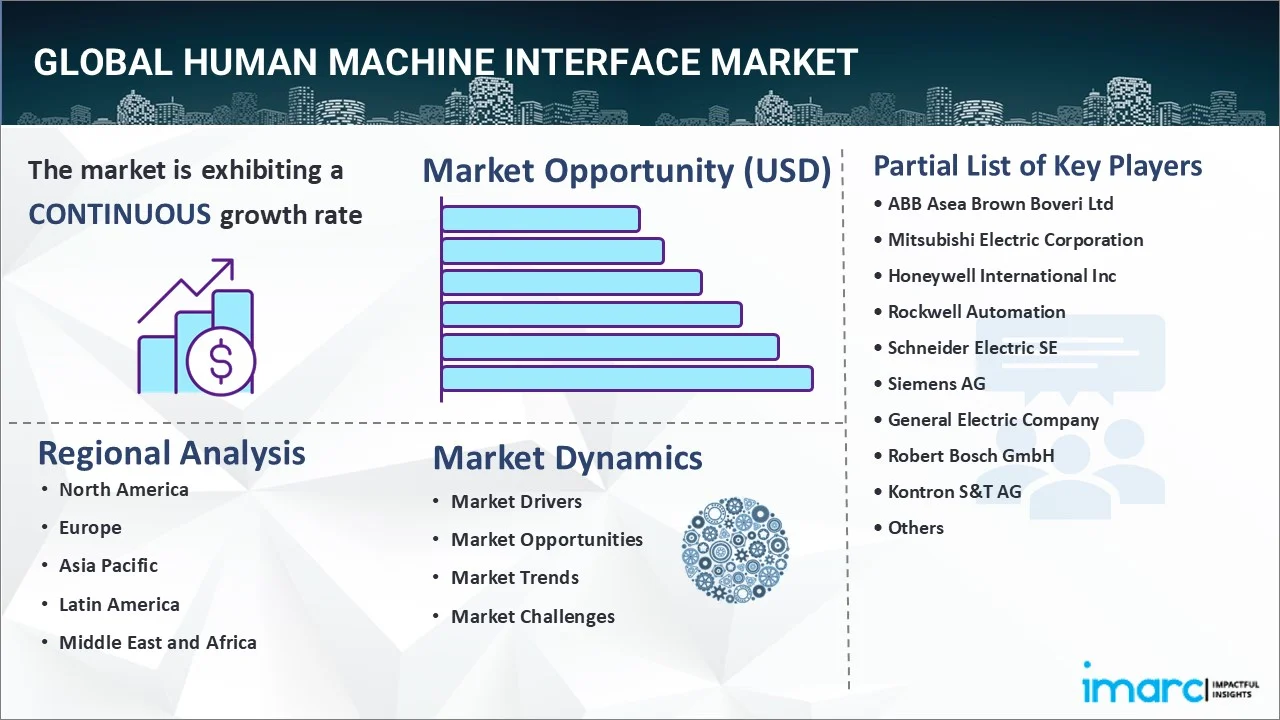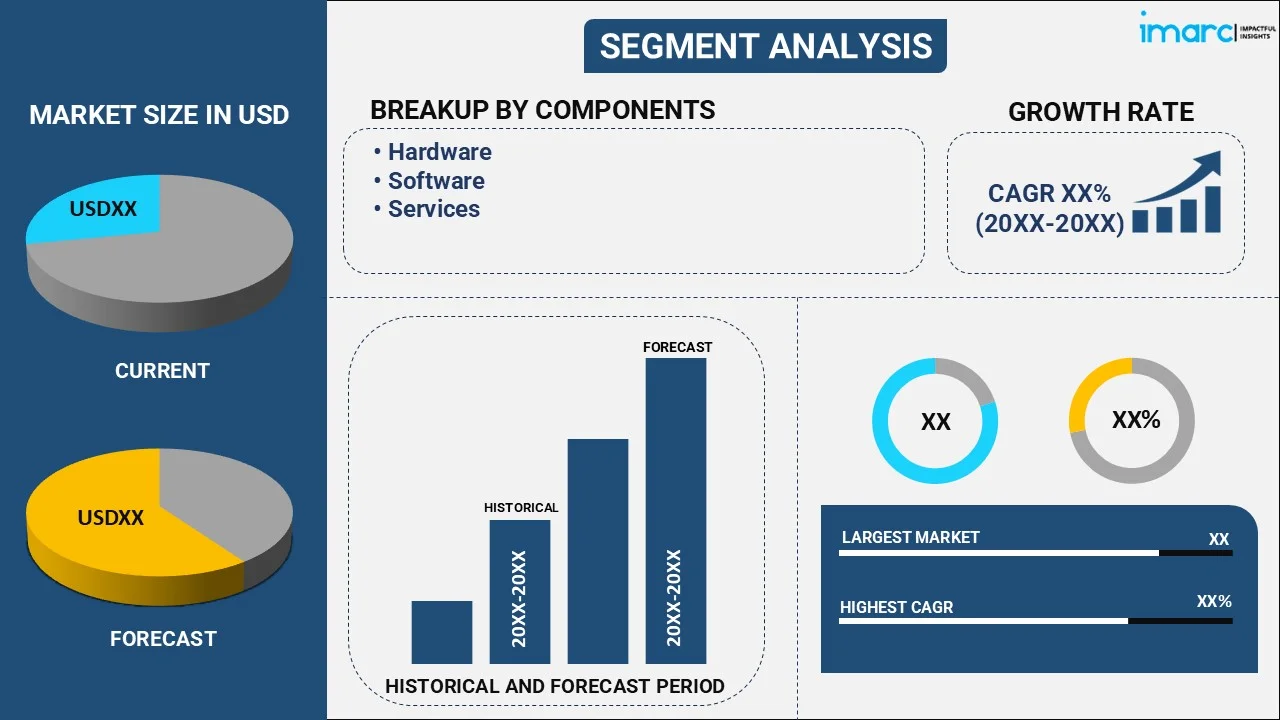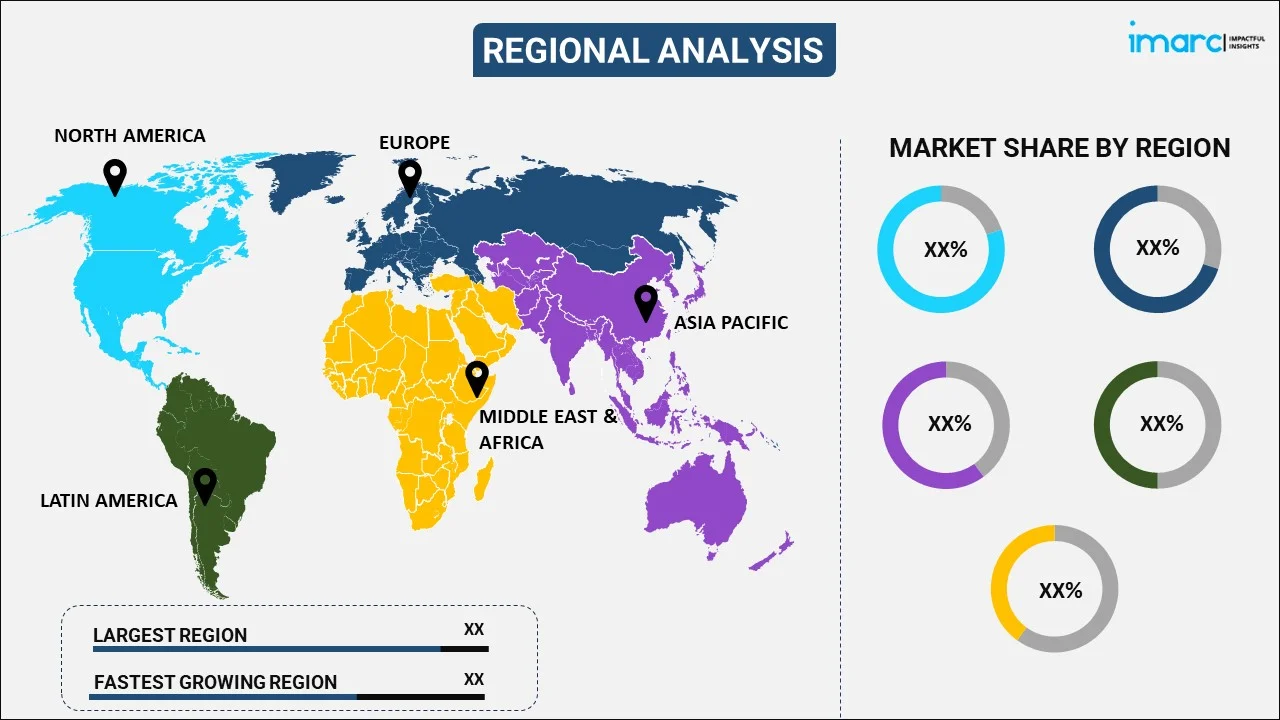
Human Machine Interface Market Report by Component (Hardware, Software, Services), Configuration (Embedded, Standalone), Technology Type (Motion HMI, Bionic HMI, Tactile HMI, Optical HMI, Acoustic HMI), End Use Industry (Packaging, Food and Beverage, Automotive, Pharmaceuticals, Utilities, Metals and Mining, and Others), and Region 2025-2033
Global Human Machine Interface Market:
The global human machine interface market size reached USD 5.5 Billion in 2024. Looking forward, IMARC Group expects the market to reach USD 9.4 Billion by 2033, exhibiting a growth rate (CAGR) of 6.02% during 2025-2033. The rising popularity of automation across several industry verticals is bolstering the market. At present, North America holds the largest market share, driven by rapid advancements in the manufacturing and automotive industries.
|
Report Attribute
|
Key Statistics
|
|---|---|
|
Base Year
|
2024
|
|
Forecast Years
|
2025-2033
|
|
Historical Years
|
2019-2024
|
|
Market Size in 2024
|
USD 5.5 Billion |
|
Market Forecast in 2033
|
USD 9.4 Billion |
| Market Growth Rate 2025-2033 | 6.02% |
Human Machine Interface Market Analysis:
- Major Market Drivers: The implementation of stringent regulations by government bodies in sectors like healthcare is one of the factors fueling the market.
- Key Market Trends: The growing demand for advanced HMI solutions in hazardous industrial environments to offer better monitoring and control capabilities is propelling the overall market.
- Competitive Landscape: Some of the prominent companies in the market include ABB Asea Brown Boveri Ltd, Mitsubishi Electric Corporation, Honeywell International Inc, Rockwell Automation, Schneider Electric SE, Siemens AG, General Electric Company, Robert Bosch GmbH, Kontron S&T AG, Yokogawa India Ltd., Advantech Co. Ltd., Texas Instruments Incorporated, and Eaton Corporation, among many others.
- Geographical Trends: The wide accessibility of advanced technologies and the expanding requirement for automation software are contributing to the market in North America.
- Challenges and Opportunities: One of the limitations hindering the market is the complexity of integrating diverse technologies into a cohesive user experience. However, standardized frameworks are expected to bolster the market in the coming years.

Human Machine Interface Market Trends:
Rising AI Incorporation
Artificial intelligence enables HMIs to learn from environmental conditions and user interactions, thereby offering more intuitive and adaptive interfaces. Besides this, the inflating need for predictive maintenance alerts and optimizing user workflows is escalating the human machine interface market demand. For example, in April 2024, Northwestern VLSI Lab delivered AI-empowered neural processing for smart biomedical devices and human machine interfaces. Apart from this, Siemens' Simatic HMI is gaining traction, as it enhances decision-making processes.
Increasing Focus on Personalization
The rising emphasis on enhanced user experience is acting as a growth-inducing factor. Besides this, key players are introducing modern product variants with features, such as customizable interfaces, high-definition displays, advanced graphical elements, etc. For instance, the Advantech ADAM-60xx series provides user-friendly interfaces with clear, intuitive controls and visualizations. Human machine interface manufacturers emphasize the importance of designing HMIs that are not only functional but also enhance overall productivity and minimize training time.
Growing Popularity of Modular Designs
Customizable options are becoming extremely important, as they allow for optimal flexibility and adaptability to diverse applications. The B&R Automation Power Panel series enables users to configure and expand their interfaces according to specific needs, thereby integrating different functionalities and components as required. Additionally, in March 2024, Beijer Electronics developed comprehensive human-machine interface technology that ensures equipment transmits high-speed and reliable wireless data in harsh environments.
Global Human Machine Interface Industry Segmentation:
IMARC Group provides an analysis of the key trends in each segment of the market, along with the human machine interface market forecast at the global and regional levels for 2025-2033. Our report has categorized the market based on the component, configuration, technology type, and end use industry.
Breakup by Component:

- Hardware
- Basic HMI
- Advanced Panel-Based HMI
- Advanced PC-Based HMI
- Software
- On-Premise HMI
- Advanced Panel-Based HMI
- Advanced PC-Based HMI
- Services
Hardware (advanced PC-based HMI) dominates the market
The report has provided a detailed breakup and analysis of the market based on the component. This includes hardware (basic HMI, advanced panel-based HMI, and advanced PC-based HMI), software (on-premise HMI, advanced panel-based HMI, and advanced PC-based HMI), and services. According to the report, hardware (advanced PC-based HMI) represented the largest market segmentation.
Advanced PC-based HMI finds extensive industrial and commercial applications, as it offers optimal processing power, enhanced flexibility, and user interactivity. For example, the SIMATIC HMI TP700 comfort panel by Siemens combines high-resolution displays with advanced touch capabilities. This, in turn, is augmenting the human machine interface market outlook across the segmentation.
Breakup by Configuration:
- Embedded
- Standalone
Embedded currently holds most of the total human machine interface market share
The report has provided a detailed breakup and analysis of the market based on the configuration. This includes embedded and standalone. According to the report, embedded represented the largest market segmentation.
Embedded human-machine interface is used, owing to its efficient integration into a wide range of devices. The Mitsubishi Electric GOT2000 series, equipped with advanced graphics, high-resolution touchscreens, and connectivity options, is gaining traction.
Breakup by Technology Type:
- Motion HMI
- Bionic HMI
- Tactile HMI
- Optical HMI
- Acoustic HMI
Tactile HMI holds the majority of the global human machine interface market revenue
The report has provided a detailed breakup and analysis of the market based on the technology type. This includes motion HMI, bionic HMI, tactile HMI, optical HMI, and acoustic HMI. According to the report, tactile HMI represented the largest market segmentation.
Tactile HMI incorporates switches, physical buttons, or other touch-sensitive elements that provide haptic feedback. The Synaptics ClearPad series enhances touchscreen interactions with precision, which is propelling the segment.
Breakup by End Use Industry:
- Packaging
- Food and Beverage
- Automotive
- Pharmaceuticals
- Utilities
- Metals and Mining
- Others
Packaging dominates the human machine interface market statistics
The report has provided a detailed breakup and analysis of the market based on the end use industry. This includes packaging, food and beverage, automotive, pharmaceuticals, utilities, metals and mining, and others. According to the report, packaging represented the largest market segmentation.
The inflating need among the packaging industry to improve operational efficiency and reduce downtime is stimulating the segment's growth. For instance, the Rockwell Automation PanelView 5500 series allows packaging operators to monitor machinery with greater precision.
Breakup by Region:

- North America
- Europe
- Asia Pacific
- Middle East and Africa
- Latin America
North America exhibits a clear dominance in the market
The human machine interface market research report has also provided a comprehensive analysis of all the major regional markets, which include North America, Europe, Asia Pacific, the Middle East and Africa, and Latin America. According to the report, North America accounted for the largest market share.
The introduction of multimodal HMI solutions that allow users to operate several functions of automobiles, particularly in countries like the U.S., is propelling the regional market. As per the IMARC, the United States human machine interface market size reached about USD 1.6 Billion in 2023. Looking forward, IMARC Group expects the market to reach USD 2.5 Billion by 2032, exhibiting a growth rate (CAGR) of 4.8% during 2024-2032.
Competitive Landscape:
Companies are partnering with software providers, hardware manufacturers, and even their end-users to co-develop tailored solutions. Besides this, they are acquiring smaller companies with specialized expertise or unique technologies to quickly diversify their product portfolio and tap into niche market segments. Additionally, leading companies are establishing operations in different countries and regions to capture emerging market share and better understand localized industrial needs, which is one of the human machine interface price trends. Moreover, they are further expanding their product lines to include a wide range of HMI solutions, from simple text-based interfaces to highly advanced PC-based systems, which enable them to cater to various industrial sectors and applications.
The market research report has provided a comprehensive analysis of the competitive landscape. Detailed profiles of all major market human machine interface companies have also been provided. Some of the key players in the market include:
- ABB Asea Brown Boveri Ltd
- Mitsubishi Electric Corporation
- Honeywell International Inc.
- Rockwell Automation
- Schneider Electric SE
- Siemens AG
- General Electric Company
- Robert Bosch GmbH
- Kontron S&T AG
- Yokogawa India Ltd.
- Advantech Co. Ltd.
- Texas Instruments Incorporated
- Eaton Corporation
(Please note that this is only a partial list of the key players, and the complete list is provided in the report.)
Human Machine Interface Market Recent Developments:
- July 2024: Weintek USA introduced a new, UL Listed, and sunlight-readable human machine interface that offers a wide viewing angle of 85° in any direction.
- April 2024: Northwestern VLSI Lab delivered AI-empowered neural processing for smart biomedical devices and human machine interfaces.
- March 2024: Beijer Electronics developed comprehensive human-machine interface technology that ensures equipment transmits high-speed and reliable wireless data in harsh environments.
Human Machine Interface Market Report Scope:
| Report Features | Details |
|---|---|
| Base Year of the Analysis | 2024 |
| Historical Period | 2019-2024 |
| Forecast Period | 2025-2033 |
| Units | Billion USD |
| Scope of the Report | Exploration of Historical Trends and Market Outlook, Industry Catalysts and Challenges, Segment-Wise Historical and Predictive Market Assessment:
|
| Components Covered |
|
| Configurations Covered | Embedded, Standalone |
| Technology Types Covered | Motion HMI, Bionic HMI, Tactile HMI, Optical HMI, Acoustic HMI |
| End Use Industries Covered | Packaging, Food and Beverage, Automotive, Pharmaceuticals, Utilities, Metals and Mining, Others |
| Regions Covered | Asia Pacific, Europe, North America, Latin America, Middle East and Africa |
| Companies Covered | ABB Asea Brown Boveri Ltd, Mitsubishi Electric Corporation, Honeywell International Inc, Rockwell Automation, Schneider Electric SE, Siemens AG, General Electric Company, Robert Bosch GmbH, Kontron S&T AG, Yokogawa India Ltd., Advantech Co. Ltd., Texas Instruments Incorporated, Eaton Corporation, etc. |
| Customization Scope | 10% Free Customization |
| Post-Sale Analyst Support | 10-12 Weeks |
| Delivery Format | PDF and Excel through Email (We can also provide the editable version of the report in PPT/Word format on special request) |
Key Questions Answered in This Report:
- How has the global human machine interface market performed so far, and how will it perform in the coming years?
- What are the drivers, restraints, and opportunities in the global human machine interface market?
- What is the impact of each driver, restraint, and opportunity on the global human machine interface market growth?
- What are the key regional markets?
- Which countries represent the most attractive human machine interface market?
- What is the breakup of the market based on component?
- Which is the most attractive component in the human machine interface market?
- What is the breakup of the market based on configuration?
- Which is the most attractive configuration in the human machine interface market?
- What is the breakup of the market based on technology type?
- Which is the most attractive technology type in the human machine interface market?
- What is the breakup of the market based on end use industry?
- Which is the most attractive end use industry in the human machine interface market?
- What is the competitive structure of the global human machine interface market?
- Who are the key players/companies in the global human machine interface market?
Key Benefits for Stakeholders:
- IMARC's industry report offers a comprehensive quantitative analysis of various market segments, historical and current market trends, market forecasts, and dynamics of the human machine interface market from 2019-2033.
- The research report provides the latest information on the market drivers, challenges, and opportunities in the global human machine interface market.
- The study maps the leading, as well as the fastest-growing, regional markets.
- Porter's five forces analysis assists stakeholders in assessing the impact of new entrants, competitive rivalry, supplier power, buyer power, and the threat of substitution. It helps stakeholders to analyze the level of competition within the human machine interface industry and its attractiveness.
- The competitive landscape allows stakeholders to understand their competitive environment and provides insight into the current positions of key players in the market.
Need more help?
- Speak to our experienced analysts for insights on the current market scenarios.
- Include additional segments and countries to customize the report as per your requirement.
- Gain an unparalleled competitive advantage in your domain by understanding how to utilize the report and positively impacting your operations and revenue.
- For further assistance, please connect with our analysts.
 Inquire Before Buying
Inquire Before Buying
 Speak to an Analyst
Speak to an Analyst
 Request Brochure
Request Brochure
 Request Customization
Request Customization




.webp)




.webp)












